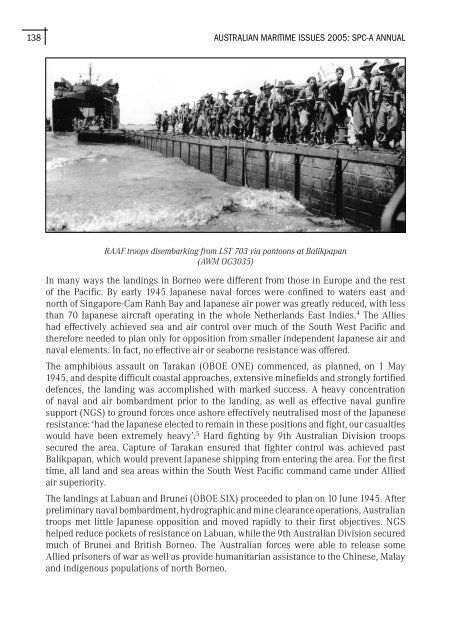Australian Maritime Issues 2005 - Royal Australian Navy
Australian Maritime Issues 2005 - Royal Australian Navy
Australian Maritime Issues 2005 - Royal Australian Navy
Create successful ePaper yourself
Turn your PDF publications into a flip-book with our unique Google optimized e-Paper software.
138<br />
AUSTRALIAN MARITIME ISSUES <strong>2005</strong>: SPC-A ANNUAL<br />
RAAF troops disembarking from LST 703 via pontoons at Balikpapan<br />
(AWM OG3035)<br />
In many ways the landings in Borneo were different from those in Europe and the rest<br />
of the Pacific. By early 1945 Japanese naval forces were confined to waters east and<br />
north of Singapore-Cam Ranh Bay and Japanese air power was greatly reduced, with less<br />
than 70 Japanese aircraft operating in the whole Netherlands East Indies. 4 The Allies<br />
had effectively achieved sea and air control over much of the South West Pacific and<br />
therefore needed to plan only for opposition from smaller independent Japanese air and<br />
naval elements. In fact, no effective air or seaborne resistance was offered.<br />
The amphibious assault on Tarakan (OBOE ONE) commenced, as planned, on 1 May<br />
1945, and despite difficult coastal approaches, extensive minefields and strongly fortified<br />
defences, the landing was accomplished with marked success. A heavy concentration<br />
of naval and air bombardment prior to the landing, as well as effective naval gunfire<br />
support (NGS) to ground forces once ashore effectively neutralised most of the Japanese<br />
resistance: ‘had the Japanese elected to remain in these positions and fight, our casualties<br />
would have been extremely heavy’. 5 Hard fighting by 9th <strong>Australian</strong> Division troops<br />
secured the area. Capture of Tarakan ensured that fighter control was achieved past<br />
Balikpapan, which would prevent Japanese shipping from entering the area. For the first<br />
time, all land and sea areas within the South West Pacific command came under Allied<br />
air superiority.<br />
The landings at Labuan and Brunei (OBOE SIX) proceeded to plan on 10 June 1945. After<br />
preliminary naval bombardment, hydrographic and mine clearance operations, <strong>Australian</strong><br />
troops met little Japanese opposition and moved rapidly to their first objectives. NGS<br />
helped reduce pockets of resistance on Labuan, while the 9th <strong>Australian</strong> Division secured<br />
much of Brunei and British Borneo. The <strong>Australian</strong> forces were able to release some<br />
Allied prisoners of war as well as provide humanitarian assistance to the Chinese, Malay<br />
and indigenous populations of north Borneo.

















